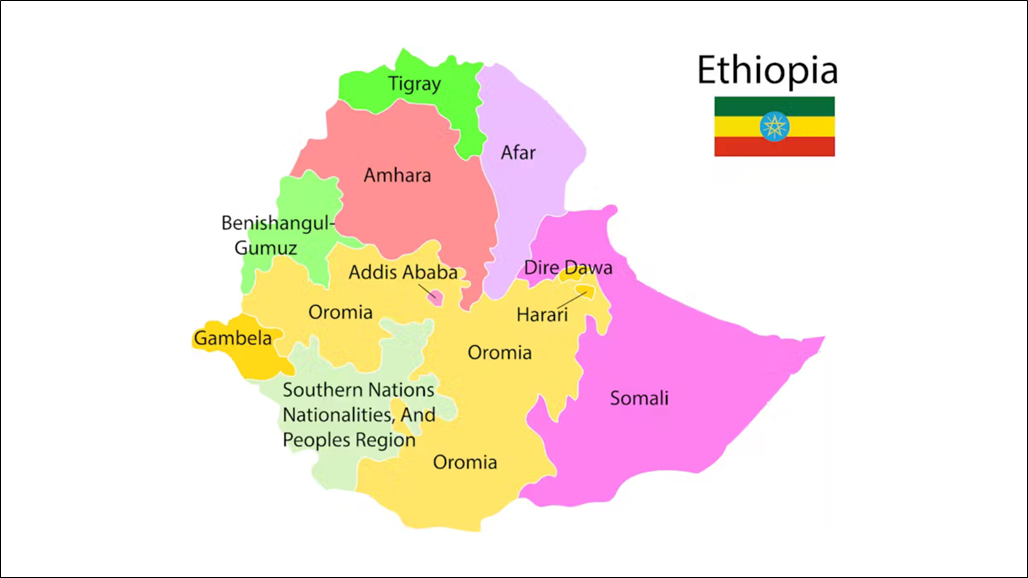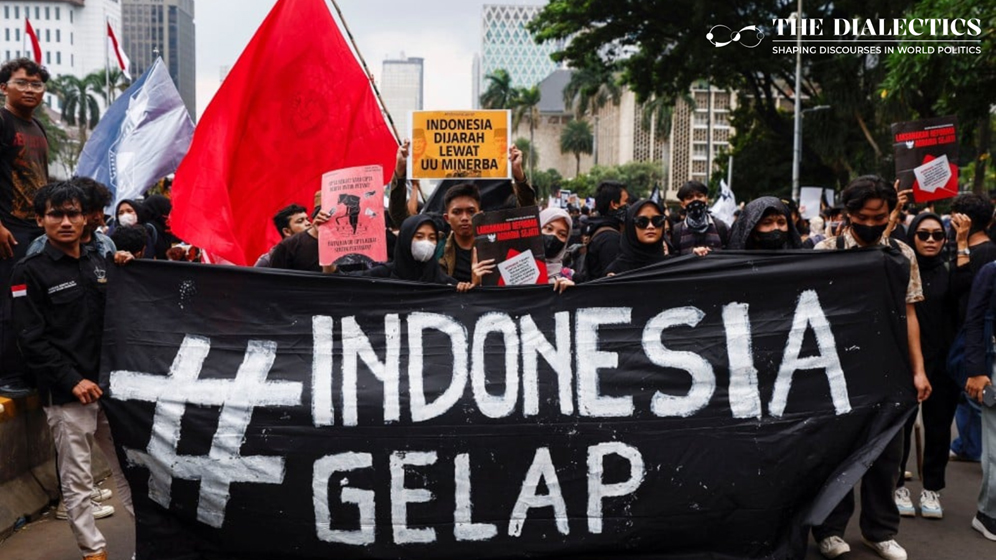The landscape of Ethiopia is a vivid tapestry of distinct ethnicities. It is often recognized for its resilience amid the prolonged ethnic contentions. This nation has mostly been steered by the pronounced (majority) ethnic group (namely Amharas, Tigray and Orhomos) who largely pursued policies that catered for their interests. Frantz Fanon has denounced such mechanisms and advocated for the dismantling of colonial structures that the elites could possibly exploit (here, the ethnic majority) in the post-colonial era. The article tries to delineate how Fanon’s understanding of the post-colonial trajectory, particularly the bourgeoisie elitism that persists in the post-colonial era, reverberates with the precarious scenario of Ethiopia.
American President Bill Clinton predicted in 1994 that democratization would neutralize armed conflict. However, the reality for the Federal Democratic Republic of Ethiopia has turned out to be a bit more complex. Despite being a Democracy (at least structurally), Ethiopia’s past has remained entrenched in ethnic contention and consequent secessions that followed. The detrimental factor that resulted in such secessions along with the recent Tigray conflict in 2020 and the ongoing Amhara crisis, has arisen from the fact that Ethiopia hosts more than 80 distinct ethnicities that are loosely bounded by the idea of Ethnic Federalism, which binds them together in a single sovereign state.
Ethiopia’s fragile Ethnic Federalism
For a democracy to thrive, it is imperative to have inclusive governance and national unity. The 1995 Constitution of Ethiopia was framed upon the principles of ethnic federalism that granted substantial autonomy to each ethnicity. However, it is mandatory for these autonomous regions to oblige the economic and social development policies of the federal government. Along with it, these autonomous regions are granted a peculiar right that is articulated in Article 39 of the Ethiopian constitution. That is the right to secede at any point in time, which indeed is progressive in nature, but at its core, it imperils Ethiopian sovereignty.
Thus, the ethno-federalist system is often alleged to have ‘inadvertently entrenched the ethnic divisions’. While it was curated to sustain the ethnic vibrancies, it has certainly failed to keep the sovereignty of the nation. As per the last official census in 2007, the Oromos constitute the largest ethnic group, making up 35.8% of the populace, followed by the Amhara, who account for around 24.1%, and are the second largest ethnic group. Then there are Somalis, who represent 7.2%, while the Tigrayan populace accounts for 5.7%. Further, Sidama constitutes around 4.1% of the population, followed by Gurage at 2.6%.
Amharas vs Tigrays vs Oromos
The Amharas and Tigrays have disproportionately dominated the political apparatus of Ethiopia throughout much of its past. The Amhara mostly dominated during the reign of Menelik II from 1889 to 1913 and later during the reign of Haile Selassie from 1930 till 1974. During this era of Amhara supremacy, the Tigrayans and Oromos were substantially marginalized. Later, during the Marxist military junta or the Derg Regime that reigned from 1974 to 1991 was primarily led by Mengistu Haile Mariam. He had roots in both Oromo-Amhara ethnicity, but even during this period, the Amhara elitism remained significant.
By 1991, the Derg was succeeded by the Tigray People’s Liberation Front (TPLF) which was led by the Ethiopian People’s Revolutionary Democratic Front (EPRDF). It was under Meles Zenawi that the Tigrays held significant sway over other ethnic groups; this time, Amharas and Oromos were significantly sidelined. However, after Zenawi’s demise in 2012, Hailemariam Desalegn came to power who hailed from the Southern Nations, Nationalities and Peoples’ Region (SNNPR), and he had been the sole leader outside the Amhara and Tigray elite who manoeuvred the politics of Ethiopia. Nevertheless, Desalegn was perceived as a feeble leader, and the Tigrayan elite remained the de facto rulers.
In April of 2018, a silver lining was apparent when Abiy Ahmed Ali came forth as the prime minister. His cosmopolitan background, which has roots of both Muslim-Oromo and Christian-Amhara, catalyzed his path to power. Yet again, the leadership was narrowly held by a dominant ethnicity that had had influence in the past as well. Progressive reforms marked his rise by revoking restrictions over exiled leaders and upholding political and journalistic freedom. His most remarkable achievement was negotiating a truce deal with Eritrea after a prolonged rift (since 1961 when Eritrea seceded), which earned him the Nobel Peace Prize in 2019. Soon, his clout was marred when he was accused of ‘Romizing Ethiopia. ‘
The recent upheavals against the federal government of Abiy Ahmed Ali were first marked in November 2020 by the Tigray populace when they resented Ahmed’s call to postpone the election under the pretext of the pandemic. The Tigrays suspected foul play on the part of Ahmed, and the state got engulfed in a civil war till the Pretoria Agreement, aka the Cessation of Hostilities Agreement (CoHA), was signed on the 2nd of November 2022. However, soon another hostile rhetoric followed when Amhara’s resentment surfaced in April 2023. It had erupted out of insecurity among the Amharas, who feared disbanding their ethno- nationalist militant wing, aka Fano (a volunteer soldier), would subside their security. By August 2023, the clashes between the Fano and Ethiopian National Defense Force (ENDF) intensified, and the federal government imposed a state of emergency in the Amhara region.
It is much apparent that the ball of power has always been played back and forth among these pronounced ethnic groups of Amhara, Oromo, and the Tigray. This domination of pronounced ethnicity in the seat of power, despite being a Federal Republic which vowed to address heterogeneity, has disrupted the equilibrium of a federal state. This elite domination or more precisely the domination of majority ethnicity, by disregarding the presentation or participation of minor ethnic groups (regardless of intent) does jeopardize the federal mechanism that proposed to preserve the ethnic vibrancy and promised to uphold inclusion.
Through the eyes of Fanon
In his 1961 work, The Wretched of the Earth, Frantz Fanon has critiqued the colonial mechanism that often persists in the post-colonial era. Though it is imperative to note that Ethiopia was colonized for a very brief span from 1935 to 1941 by Italy (during Mussolini’s reign). But Ethiopia failed to curate an apparatus that disregarded the colonial traits. Its tendency to monopolize by certain majority ethnic groups is nearly identical with Bourgeois dominance that Fanon critiques of in his work. This trait has been evident in Ethiopian politics where political elites consolidate power based on their ethnic heritage.
Fanon noted that the post-colonial bourgeoisie often seeks to rule solely based on race or ethnicity. Throughout the imperial era, particularly during the reign of Menelik II and Haile Selassie, a unified Northern culture irrespectively over the heterogeneous populace was imposed. They pursued a strong mechanism towards Amharization along with Christianizing, which was perceived as an imperative step towards curating an inclusive nation-state. They tried to homogenize the landscape often by subjugating and suppressing the non-Amhara ethnicities. This homogeneity based on ethnicity or race is critiqued by Fanon, which he believed could be manoeuvred by the bourgeoisie to consolidate power.
Fanon was convinced that the emerging bourgeoisie in a newly independent or underdeveloped nation often tries to dominate the nation’s affairs in an authoritarian manner or even as a dictator. This was evident in Ethiopia during the Derg reign when the regime ruled with an iron fist under the pretext of welfare while suppressing dissent. Moreover, during the Derg regime, the opposition groups of Oromo and Amhara were often marginalized, and it is estimated that more than 7 lakh people were executed during this era of the Red Terror.
Fanon has noted how the state becomes ‘increasingly provocative’, and the law enforcement and security forces often utilize violence to quell opposition. In the post-2018 era, the Amhara community has endured a series of cruelty like targeted killings, rape, mutilation, and imprisonment, and the fingers have been pointed at the federal government of Abiy Ahmed Ali. Fanon has underscored the perils of ethnic polarization and the potential of state violence to exacerbate political instability.
Thus, an equitable society in Ethiopia is often undermined by the inter-ethnic conflicts that overwhelm state politics. In 1991, the Tigrays revolted against the marginalization of the dominant Amharas, and likewise, in 2018, Oromo ascended to power, challenging the Tigray domination. Moreover, with the Oromo ascendancy, the Amhara have felt sidelined and have accused the federal government of Abiy Ahmed Ali of ‘Oromizing Ethiopia. Hence, the power rivalry in Ethiopia has been extant.
A nascent form of internal colonialism has been evident for a long time now. Although the EPRDF was introduced with the intent to address the ethnic grievances by fostering autonomy, in reality it worsened the scenario by proliferating the ethnic fractures and downplaying the voices of minor ethnicities. The evolving ethnic crisis of the Amharas with the federal government or even the Tigray uprising of 2020 exhibits ethnic polarisation exacerbating the political catastrophe in Ethiopia.
Hence, in Ethiopia, the shrewd existence of democracy is fundamentally flawed; here, the demography influences the power dynamics. Thus, it is apt to conclude that the Federalist approach is likely to disintegrate the nation eventually. For Ethiopia to evade a state failure, it is essential to dismantle the hegemony of ethnic elitism at the apex positions. Fanon had advocated for an absolute renunciation of the existing colonial framework, and his advocacy was not merely about independence or decolonization. Rather, he stressed fundamentally restructuring the structures where no soul is subjugated. It is imperative to restructure the political apparatus to ensure a more just representation and enforce a sense of inclusivity that would secure sovereignty in the long run.




